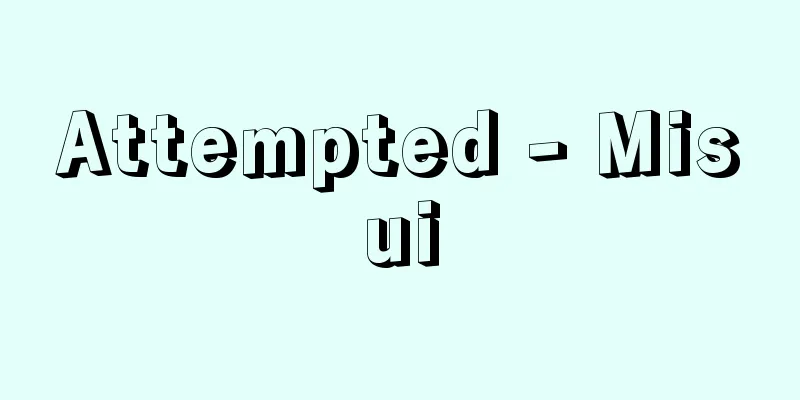Hirokimi Otomo - Hirokimi Otomo

|
Other examples include the etymological dictionary Miyogoki (10 volumes) (written by Keison, completed in 1275 (Kenji 1)), the similar book Chiribukuro (11 volumes) (perhaps completed around Bun'ei-Kōan period (1264-88)), the oldest alphabet dictionary Onkochishinshi (written by Otomo no Hirokuni, completed in 1484 (Bunmei 16)), and Unpo Shikiyoshu (1548 (Tenbun 17)), which only had an Iroha classification but no semantic classification. Of these, Wagyokuhen, Gegakushu, and Setsuyōshu were the most widely used, and continued to be used throughout the Edo period. Examples of dictionaries of Japanese words include Jokaku's Waka Shikiyo (3 volumes) (perhaps completed in 1198 (Kenkyu 9)), and Juntokuin's Yakumo Mishou (6 volumes). From the dictionary:Other examples include the etymological dictionary Miyogoki (10 volumes) (written by Keison, completed in 1275 (Kenji 1)), the similar book Chiribukuro (11 volumes) (perhaps completed around Bun'ei-Kōan period (1264-88)), the oldest alphabet dictionary Onkochishinshi (written by Otomo no Hirokuni, completed in 1484 (Bunmei 16)), and Unpo Shikiyoshu (1548 (Tenbun 17)), which only had an Iroha classification but no semantic classification. Of these, Wagyokuhen, Gegakushu, and Setsuyōshu were the most widely used, and continued to be used throughout the Edo period. Examples of dictionaries of Japanese words include Jokaku's Waka Shikiyo (3 volumes) (perhaps completed in 1198 (Kenkyu 9)), and Juntokuin's Yakumo Mishou (6 volumes). *Some of the terminology that refers to "Otomo Hiroki" is listed below. Source | Heibonsha World Encyclopedia 2nd Edition | Information |
|
…このほか語源辞書の《名語記(みようごき)》10巻(経尊著。1275(建治1)成立),類書の《塵袋(ちりぶくろ)》11巻(文永~弘安期(1264‐88)ころ成立か),最古の五十音引き辞書として《温故知新書(おんこちしんしよ)》(大伴広公著,1484(文明16)成立),イロハ分類だけで意味分類のない《運歩色葉集》(1548(天文17)成立)などが現れたが,これらの中で《和玉篇》《下学集》《節用集》は最も広く行われ,江戸時代におよんだ。 和語の語釈の辞書としては,上覚の《和歌色葉》3巻(1198(建久9)成立か),順徳院の《八雲御抄(やくもみしよう)》6巻などがある。… 【辞書】より…このほか語源辞書の《名語記(みようごき)》10巻(経尊著。1275(建治1)成立),類書の《塵袋(ちりぶくろ)》11巻(文永~弘安期(1264‐88)ころ成立か),最古の五十音引き辞書として《温故知新書(おんこちしんしよ)》(大伴広公著,1484(文明16)成立),イロハ分類だけで意味分類のない《運歩色葉集》(1548(天文17)成立)などが現れたが,これらの中で《和玉篇》《下学集》《節用集》は最も広く行われ,江戸時代におよんだ。 和語の語釈の辞書としては,上覚の《和歌色葉》3巻(1198(建久9)成立か),順徳院の《八雲御抄(やくもみしよう)》6巻などがある。… ※「大伴広公」について言及している用語解説の一部を掲載しています。 出典|株式会社平凡社世界大百科事典 第2版について | 情報 |
<<: Otomo Makuda - Otomo Makuda
Recommend
Eros
(Erōs)⸨Eros⸩[1][1] Greek god of love. Son of Aphro...
Polystyrene
...A typical general-purpose thermoplastic resin ...
Premature Labor
[What kind of disease is it?] Delivery between 22 ...
Supervisory and corrective power
… [Right to self-interest and right to common int...
tube
...A general term for a hollow object that can va...
amyl acetate
...It is a liquid with a boiling point of 142°C a...
Gustaf Gründgens
1899‐1963 West German actor and director. After wo...
Polish Music - Polish Music
With the spread of Christianity around 1000, Polis...
Okitama region
...In addition to fruit trees, the Yamagata Basin...
Treasury of Atreus
One of the most representative tholos-type tombs, ...
Emperor Jianwen
The second emperor of the Southern Liang Dynasty ...
Acute diarrhea - Kyuuseigeri
…Furthermore, diarrhea may occur due to insuffici...
Gyoshitaifu - Chief Censor
〘Noun〙① A Chinese official title. During the Qin a...
Gumbel, CWvon (English spelling) GumbelCWvon
…This term was coined in 1868 by German geologist...
Yamataka Shigeri - Yamataka Shigeri
Feminist. Born in Mie Prefecture. Dropped out of ...



![Asai [town] - Azai](/upload/images/67cad28a93c98.webp)





